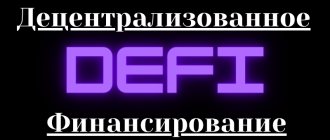Blockchain was created to destroy the current financial system, but after ten years, experts see in it a technology that can modernize the entire existing world - the distribution registry. Its mechanism is universal, applicable in almost all industries and has significant advantages over standard data storage systems. ProstoCoin specialists tell you the details.
What is a distributed registry
Distributed Ledger Technology is a data storage technology that distributes information among multiple communication nodes or between computing devices. This distribution scheme has several key features:
- lack of a central administrator;
- sharing with synchronization according to a given algorithm;
- decentralized geographic distribution of database copies between all communication nodes.
At its core, this is the first database that eliminates the need to use a central service and distributes the database across all communication nodes, making them responsible for supporting the system and checking information.
Each node makes changes to the registry independently of other nodes, then they all vote on making changes and when consensus is reached, the registry is updated with new data. Each network participant has its own identical copy of the registry, and any changes are made to it within a few minutes.
The distribution register has become known to a wide range of people, mainly due to its use in the cryptocurrency blockchain, but any data can be systematized in this way: financial, legal, statistical, electronic and others.
Unlike traditional databases, distribution registries are much better protected from attacks and unauthorized changes to data, since the copies are geographically distant from each other and a hacker change would require an attack on all communication nodes at once. In addition, the nodes will detect unauthorized changes and will not support entering data.
Data Layer
The protocol layer determines how the system will operate and what rules it will follow.
The network layer implements the underlying principles of the protocol. Together, the protocol and network layers form the basis for the data layer, which accumulates over time as transactions are recorded in a list of confirmed records. Operations
The operations component includes all the processes by which participants interact with the system.
Data sources
The input process refers to the source or method of obtaining data for the protocol. Data sources can be internal or external, which can reflect active user interaction with the system, a change in protocol state caused by an internal system process or received externally (for example, a transaction sent from another protocol) or a smart contract.
We define internal input sources as any record or transaction created by the user or due to the result of user interaction with the protocol. External input sources, on the other hand, are the result of input from other systems that interact with the protocol, but which are in principle separate from the underlying platform (i.e. they are dependent or interoperable). Hybrid protocols allow users to transmit transactions using a "state channel" at any time, however, the development of these methods is still in its early stages.
Table 9. Data entry forms
Software-executable transactions
Not all data layer changes are a direct result of internal or external inputs. Some changes in the system occur due to the execution of program code instructions. A striking example is smart contracts. When the embedded program code is executed, a change in the state of the network occurs in the protocol, for example, a transaction occurs that is recorded in the list of confirmed ones. Some DLT systems only support scripting language. For example, Bitcoin Script, it works simply in a scripting language that allows you to create limitedly simple programs. Such systems are called Stateless. Ethereum (Solidity), Tezos (Michelson) and EOS (WebAssembly) all support Turing-complete programming languages for developing complex smart contracts, while Bitcoin and Monero use a scripting language that allows limited operations.
Table 10. Properties of software-executed transactions
Actual execution of calculations
The execution location of the program determines where the calculations take place. As a rule, the execution location can be within the network - on-chain or off-chain (outside the network). On-chain calculations are performed at each node. This environment can range from a simple virtual machine, like a scripting language, to a complex one (EVM - Ethereum Virtual Machine), which ensures the execution of Turing complete programs. On-chain smart contracts are run by every node on the network and are therefore often called “self-executing”.
Off-chain computations are performed in an environment that is external to the protocol. The event that triggers the program code occurs on-chain, and the calculations occur on another system without loading the main network. There is also a Hybrid system for launching applications, for example, Plasma in Ethereum. Or, for example, Cosmos, where the main network serves as the “center”, but the calculations themselves take place in the subsidiary networks.
Table 11. Execution properties of software-executed transactions
Log Component
Links
From the moment users begin interacting with the DLT system, the log is updated over time. However, a magazine is an abstraction. All processes that occur in a DLT system belong to a specific protocol. For example, a protocol focused on electronic payments must contain information about assets owned by specific users. On the other hand, a DLT system that includes smart contracts must have its own virtual machine that implements the execution of program code. Therefore, the concept of a magazine is an abstraction.
Types of links
There are four different types of input data: endogenous, exogenous, hybrid and self-referential data.
Endogenous links refer to data that tracks information about variables that are native to the system. For example, in Bitcoin, a single endogenous reference variable is used to track the number of bitcoins that users had at a given time. This internal variable is updated as the user sends and receives bitcoins to other addresses. Exogenous (external) reference refers to data that tracks information about variables that exist outside the system. A hybrid link refers to data that has both endogenous and exogenous characteristics. There is also a fourth type that is neither endogenous nor exogenous and not a hybrid: it is a neutral or empty data type - it is a self-referential reference. For example, a smart contract is simply a piece of code that can be executed when certain conditions are met. Although a smart contract may require information about external or internal system variables, the code itself does not have an internal reference to anything outside itself (“null reference”).
Table 12. Link types and their meaning
Types of distributed ledgers
Bitcoin's distributed ledger of digital transactions is just one type of ledger-based database. Conventionally, they can all be divided:
- Public. Used in most cryptocurrencies and is an open source database. They work on Proof of Work algorithms. In such a system, each participant can download the database to their local device and participate in the agreed process of making changes. Also, anyone can view all the added information.
- Federal. Federated databases are run by a group of people. Unlike open registries, they do not allow everyone to contribute new data. The process of changing the registry is controlled exclusively by pre-selected communication nodes. They are used mainly in the banking sector and provide greater confidentiality.
- Private. Only a certain centralized organization has the right to make changes to such a register. Information may be open to public reading or restricted. Private distribution registries are typically used by companies to store internal information and conduct audits. Such systems are more vulnerable than a public blockchain, but they make it possible to modernize outdated information storage systems in companies.
DLT technology is quite diverse and allows you to store information of any kind, which makes it easily applicable in all industries that require secure data storage.
Introduction
The ledger is the basis of accounting, as ancient as writing and money. Throughout human history, clay tablets, wooden sticks, stone, papyrus and paper have been used as ledgers.
With the advent and proliferation of computers in the 1980s and 90s, paper documents were digitized, often through routine manual data entry. These early digital books emulated the cataloging and accounting of the paper world, and digitization can be said to be more applicable to the logistics of paper documents rather than their creation.
Paper media remains the basis of our society: money, stamps, written signatures, promissory notes, certificates and the use of double-entry bookkeeping.
Computing power and breakthroughs in cryptography, as well as the invention and use of some new and interesting algorithms, have made it possible to create distributed ledgers - the modern digital version of a ledger .
Where are DLTs used?
The main area of use of distribution registries now remains cryptocurrencies, where information about transactions is thus stored and the balance of user wallets is calculated.
However, using the same technology, the government and private sector could significantly modernize the process of storing and transmitting information. DLT technology is already in use in some countries.
For example, in Estonia, the development of a KSI based on the distribution register has been underway for several years, which will allow citizens to check the accuracy of information in the state database. The Estonian management system is known for its “boldness” in using the latest technologies. But the government of “conservative” England has also created a committee to study DLT technology and develop government projects based on it.
The global business community quickly appreciated the benefits of using DLT, and today this technology is used to ensure the functioning of companies. Thus, Everledger provides a distribution database that guarantees the authenticity of diamonds - which is very important in a market full of fakes.
The banking and insurance industries are considered the most promising for the implementation of the distribution register.
Assessing Database Coordination Performance
Database coordination: characteristics
While there has been in-depth analysis of the functionality of these platforms in the context of characteristics such as immutability, security, scalability, manageability and performance, it is much more helpful to establish an understanding of the foundations on which these architectures are built.
To properly coordinate data in distributed systems, many tools have been invented and implemented. An example is the strong emphasis on tools such as Hadoop and various ensembles in the ecosystem, including Spark, Hive and ZooKeeper. The use of these products demonstrates the active integration of distributed system tools and protocols. Further parallels can be seen in protocols such as Tendermint, a consensus engine that solves the Byzantine generals problem and has similar functionality to tools such as Apache ZooKeeper. Research has also been carried out towards event sourcing databases capable of reproducing some of the desired functions of coordinated data exchange systems.
By evaluating tools such as Apache Kafka and how data streaming services are able to achieve significant levels of throughput in an enterprise environment, it is possible to establish the functional differences between blockchain and distributed ledger based on the different levels of dependence on these database orchestration and optimization tools in in terms of fundamental concepts. Ethereum implementations, including Plasma, use tools like MapReduce to enhance certain map functionality on top of the UTXO and accounting model, while folding the components into Merkle proofs, although it is important to understand that the base layer of the protocol still relies on Ethereum as to the root blockchain. By understanding these details, you can gain insight into how to better evaluate the technological characteristics of these software platforms.
How does blockchain differ from distributed ledger?
Many people mistakenly believe that blockchain and distribution registry are the same thing. In fact, blockchain is a type of distribution ledger. Information in it is recorded strictly in blocks that are connected to each other in series.
Every blockchain is a distribution ledger, but not all data ledgers are blockchains. Both of these concepts are united by decentralized data storage and the need to achieve consensus between communication nodes to make changes, and the information itself can be recorded in any form.
In practice, distribution ledgers do not require the creation of blocks and do not require proof of work. Due to this, they have fewer problems with scalability.
Efficient processing and coordination of information
If improved distributed system structure or database coordination is the sole purpose of a protocol or platform, then a blockchain is not necessarily needed. Blockchain platforms have traditionally promoted the concepts of improved data coordination and distributed consensus mechanisms, where data is transferred and maintained by the technology platform. Despite their usefulness, much of this desired functionality can be achieved through improved coordination of a centralized database or improved design of distributed systems. This study seeks to determine the extent to which platforms and protocols attempt to optimize existing data coordination functionality versus introducing new blockchain functionality. Blockchains are designed to do more than just advanced data coordination.
Immutable/trusted record of products and transactions
The original thesis about why we need blockchains was built on the concept of digitalization of trust. Andrew Keys of ConsenSys promoted the following theme: “Just as the Internet led to the digitalization of information, blockchains lead to the digitalization of trust and agreements.” This insightful thesis embodies the ethos of what blockchains hope to achieve, while setting the stage for the path ahead. An additional variable can be considered the digitalization of cost. When value is tied to the trust embedded in the system, certain alignment structures and incentive mechanisms will incentivize appropriate behavior in the system, leading to a viable platform.
Immutability is often used synonymously with trust in system design, i.e. if the system is immutable, then you can trust that bad behavior will not go unpunished. But in our analysis of platform protocols, it is also important to evaluate the mechanisms for implementing a trusted system that provide a business model that can benefit platform users (further exploration through cryptoeconomics).
Asset digitalization
Digitalization of goods and assets is considered the main goal of most blockchains and distributed ledger platforms. If businesses are looking to digitalize assets, distributed ledger or coordinated databases may offer some possibilities, but much consideration must be given to the accessibility of such digital goods. Since coordinated databases are effectively centrally managed or distributed among a group or subgroups of counterparties through the old software paradigm, the level of digitalization may be limited depending on the freedom offered by the digitalization platform. Although the concept of digitalization of goods may seem like a simple process, the different motivational dynamics and economic considerations on how to digitalize products such as real estate, human attention and even electricity require serious consideration of what type of platform could be responsible for digitalization, as some retailers platforms in different cases demonstrate varying degrees of “vendor lock-in” and dependence on a centrally managed platform.
Records and ledgers, such as property rights systems and supply chains, are also implemented using distributed ledger systems, although their level of interaction with the economic motivation layer is quite limited in the case of dependence on a closed private system, and the penetration of such assets into the digital ecosystem or market when building on closed systems will be greatly slowed down. To promote true digital goods in an ever-evolving digital ecosystem, a free market system is needed that takes full advantage of the various aspects that an open market can provide.
DLT Prospects for the Financial Industry
Now the financial sector is experiencing a wave of modernization of its entire infrastructure, leading to the automation of payments. The increase in the number of online transfers and transactions requires improved security, faster mass processing of information and lower commission costs. The introduction of distribution registry technology into the financial sector helps to realize all this.
In the near future, DLT is capable of radically transforming the financial industry, increasing security through cryptographic data protection and eliminating the participation of intermediaries in transactions.
Using this technology, the bank of the future can exist without branches and be only an Internet platform based on a distribution registry, and all banking services will be provided through applications.
Smart contracts are also based on the distribution registry, making it possible to conclude secure remote transactions and implement them automatically subject to the prescribed conditions. This is especially important given the increase in investment in intangible assets.











